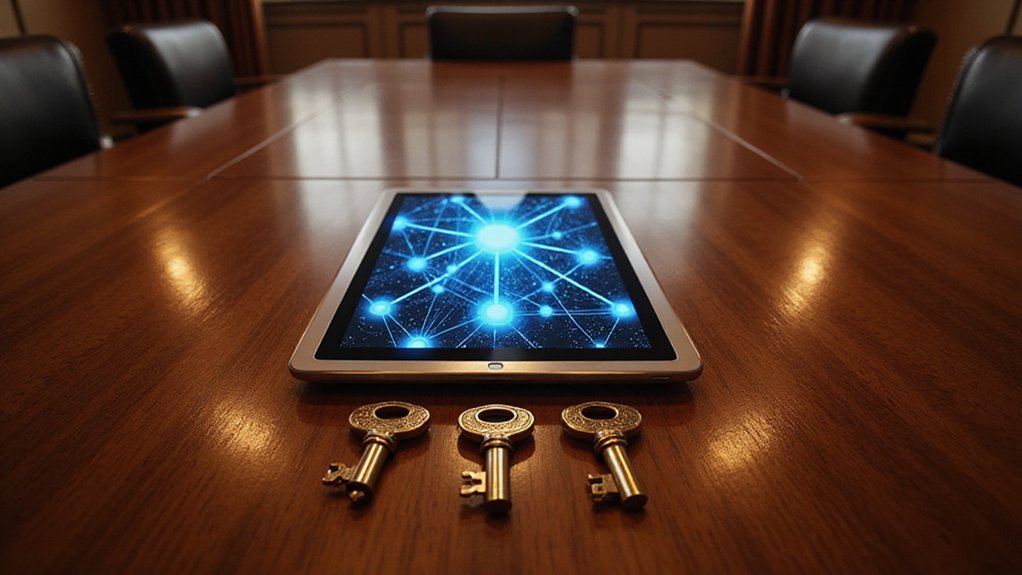Blockchain functions as a decentralized digital ledger that records transactions across multiple computers without requiring traditional financial intermediaries—a technological marvel that somehow convinced both Wall Street titans and anti-establishment crypto enthusiasts they’re backing the same horse. Each block contains cryptographically secured transaction data linked chronologically, creating an immutable chain where tampering requires altering every subsequent block. While Bitcoin confirmations take roughly an hour, this distributed architecture eliminates single points of failure that plague centralized systems, though one might wonder whether replacing banker gatekeepers with energy-intensive computational puzzles truly represents progress or merely expensive theater.

While the financial world has witnessed countless innovations promising to revolutionize how value changes hands, blockchain technology represents something genuinely different—a decentralized digital ledger that operates without the traditional gatekeepers who have long controlled monetary transactions. This distributed system stores records across a network of computers, creating transparency and immutability that would make even the most paranoid accountant weep with joy.
The architecture itself reveals blockchain’s elegant simplicity: linked blocks containing transaction data, smart contracts, or other digital assets. Each block comprises three essential components—a header with metadata and the previous block’s hash, the data section, and its own unique cryptographic fingerprint. This hash serves as an unalterable identifier, ensuring that any tampering attempts would require changing every subsequent block (a computational feat roughly equivalent to boiling the ocean with a cigarette lighter).
Security emerges through cryptographic hashing and chronological timestamping, creating an immutable chain where altering historical records becomes virtually impossible. The tamper-evident nature means fraudulent modifications are immediately detectable, assuming one bothers to look—a revitalizing concept in financial markets where oversight often resembles a blindfolded referee.
Blockchain creates tamper-evident records where fraudulent modifications become immediately detectable—assuming anyone actually bothers to look.
Consensus mechanisms enable this trustless system to function without central authority. Proof of Work requires computational effort to validate transactions, while Proof of Stake leverages stakeholders’ holdings as validation power. These algorithms allow network participants to agree on transaction validity without relying on traditional intermediaries (who, coincidentally, charge handsomely for their services). Transaction confirmation typically requires waiting for multiple subsequent blocks to be validated, with Bitcoin requiring approximately one hour for full confirmation after five additional blocks are processed.
Block time—the duration required to generate new blocks—varies markedly across different blockchain implementations. Shorter intervals enable faster transaction confirmation but increase conflict risks, while longer periods enhance stability at the expense of speed. This balance affects network performance and user experience considerably. The blockchain ecosystem has enabled the rapid growth of stablecoin adoption, which now facilitates low-cost cross-border payments and has attracted integration by major payment platforms.
The decentralized architecture distributes control across multiple nodes, eliminating single points of failure that plague centralized systems. This peer-to-peer structure enables direct participant interactions while maintaining data redundancy across the network. The blockchain’s global market expansion demonstrates its growing adoption, with projections showing growth from $17.57 billion in 2023 to approximately $470 billion by 2030.
Beyond cryptocurrency applications like Bitcoin and Ethereum, blockchain enables smart contracts that automate business logic and agreements, potentially reducing the need for traditional contract enforcement mechanisms—though lawyers everywhere maintain studied indifference to this development.
Frequently Asked Questions
What Happens to Blockchain if the Internet Goes Down Permanently?
If the internet permanently vanishes, blockchain networks would fundamentally become digital fossils—frozen ledgers incapable of processing new transactions or achieving consensus.
While individual nodes might retain their historical data, the distributed verification mechanism that makes blockchain trustworthy would collapse entirely.
Alternative communication methods (satellite, radio) offer theoretical lifelines, but without robust global connectivity, the revolutionary promise of decentralized finance would ironically depend on centralized infrastructure that no longer exists.
Can Blockchain Technology Be Hacked or Completely Destroyed by Governments?
While governments possess regulatory hammers that can severely disrupt blockchain operations—targeting exchanges, imposing compliance burdens, and restricting internet access—they cannot actually destroy the distributed ledgers themselves.
The decentralized architecture renders total eradication technically unfeasible, though state actors with sufficient computational resources might attempt costly 51% attacks.
Hackers exploit endpoint vulnerabilities and human weaknesses rather than breaching blockchain protocols directly, making users the weakest link.
How Much Electricity Does Blockchain Consume Compared to Traditional Banking Systems?
Bitcoin’s energy consumption dwarfs traditional banking systems by orders of magnitude—one Bitcoin transaction consumes electricity equivalent to hundreds of thousands of Visa transactions.
While Bitcoin mining devours roughly 168 TWh annually (matching entire countries like Finland), traditional banking leverages centralized infrastructure with superior economies of scale.
The comparison becomes rather stark when considering that blockchain’s energy appetite remains constant regardless of transaction volume, unlike banking systems’ flexible consumption patterns.
What Are the Biggest Risks of Investing in Blockchain-Based Cryptocurrencies?
Cryptocurrency investment presents four primary risk vectors: regulatory uncertainty (governments worldwide remain indecisive, potentially restricting access overnight);
security vulnerabilities (scams cost Americans $1.4 billion in 2024 alone, with irreversible transaction finality);
extreme market volatility (price swings dwarf traditional assets);
and increasingly, physical threats (home invasions targeting crypto holders).
Unlike traditional banking’s protective infrastructure, blockchain’s decentralized nature—ironically both its strength and weakness—leaves investors remarkably exposed across multiple dimensions.
Which Countries Have Banned Blockchain Technology and Why?
Several nations have implemented extensive cryptocurrency bans, though distinguishing between blockchain technology and digital currencies proves vital.
China’s sweeping 2025 prohibition, Bangladesh’s 2017 restrictions, and Afghanistan’s Taliban-imposed limitations primarily target cryptocurrency trading and mining rather than underlying blockchain infrastructure.
Motivations range from financial stability concerns and anti-money laundering enforcement to environmental impact mitigation.
Ironically, many of these same governments continue exploring central bank digital currencies—utilizing the very blockchain technology they’ve ostensibly rejected.








